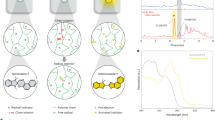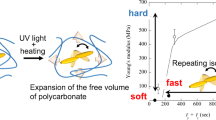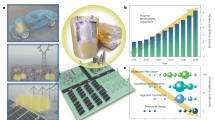Abstract
IRRADIATION of a monomer vapour frequently causes polymerization leading to the formation of a solid deposit on any convenient surface. Electrons1, ultra-violet, X-, γ-radiation or an electrical discharge2 can be used.
This is a preview of subscription content, access via your institution
Access options
Subscribe to this journal
Receive 51 print issues and online access
$199.00 per year
only $3.90 per issue
Buy this article
- Purchase on Springer Link
- Instant access to full article PDF
Prices may be subject to local taxes which are calculated during checkout
Similar content being viewed by others
References
Christy, R. W., J. App. Phys., 31, 1680 (1960).
Goodman, J., J. Polymer Sci., 44, 551 (1960).
Author information
Authors and Affiliations
Rights and permissions
About this article
Cite this article
STUART, M. Dielectric Properties of Cross-linked Polystyrene Film formed in the Glow Discharge. Nature 199, 59–60 (1963). https://doi.org/10.1038/199059b0
Issue Date:
DOI: https://doi.org/10.1038/199059b0
This article is cited by
-
Microstructural, compositional, topological and optical properties of plasma polymerized cyclohexane amorphous thin films
Journal of Polymer Research (2019)
-
Electrical properties of plasma-polymerized thin organic films
Plasma Chemistry and Plasma Processing (1983)
Comments
By submitting a comment you agree to abide by our Terms and Community Guidelines. If you find something abusive or that does not comply with our terms or guidelines please flag it as inappropriate.



